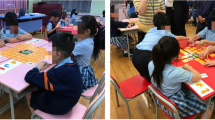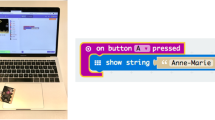Abstract
China is gradually deepening its education reform. Children’s programming education in STEAM education has caused widespread concern, however, there is no corresponding method for teaching aids design. In this paper, we conducted a comprehensive review of literatures on the development and application of STEAM education in China and globally. After analyzing current situation of children’s programming education in China, primary design principles of children’s programming teaching aids are summarized. Service design theory was utilized during the research. Five elements of the children’s programming curriculum system were summarized and design method of children’s programming teaching aids were proposed with analyzing the common points of service design and children’s programming courses. This research integrated service design concepts into children’s programming education, summarized design methods of Chinese children’s programming aids through the relationship of five elements including people, media, scenes, actions, and goals. In addition, this research proposed a new design framework named “Children – Technology – Traditional culture – Children”. The results have positive value for improving the current homogenization of the Chinese programming market, and can promote the emergence of more children’s programming teaching aids with Chinese characteristics.
Access this chapter
Tax calculation will be finalised at checkout
Purchases are for personal use only
Similar content being viewed by others
References
Bybee, R.W.: The Case for STEM Education: Challenges and Opportunities. NSTA Press, Arlington (2013)
Havice, W.: The power and promise of a STEM education: thriving in a complex technological world. In: The Overlooked STEM Imperatives: Technology and Engineering, pp. 10–17. ITEEA, Reston (2009)
Fan, S.-C., Yu, K.-C.: How an integrative STEM curriculum can benefit students in engineering design practices. Int. J. Technol. Des. Educ. 27(1), 107–129 (2015). https://doi.org/10.1007/s10798-015-9328-x
Thibaut, L., Knipprath, H., Dehaene, W., Depaepe, F.: How school context and personal factors relate to teachers’ attitudes toward teaching integrated STEM. Int. J. Technol. Des. Educ. 28(3), 631–651 (2017). https://doi.org/10.1007/s10798-017-9416-1
Jones, A., Buntting, C., de Vries, M.J.: The developing field of technology education: a review to look forward. Int. J. Technol. Des. Educ. 23, 191–212 (2013)
Kelley, T.R., Brenner, D.C., Pieper, J.T.: Two approaches to engineering design: observations in STEM education. J. STEM Teacher Educ. 47(2), 5–40 (2010)
Braund, M., Reiss, M.J.: The ‘Great Divide’: how the arts contribute to science and science education. Can. J. Sci. Math. Technol. Educ. 19(3), 219–236 (2019)
Crismond, D.P., Adams, R.S.: The informed design teaching and learning matrix. J. Eng. Educ. 101(4), 738–797 (2012)
McFadden, J., Roehrig, G.: Engineering design in the elementary science classroom: supporting student discourse during an engineering design challenge. Int. J. Technol. Des. Educ. (2018). https://doi.org/10.1007/s10798-018-9444-5
Sullivan, A., Bers, M.U.: Dancing robots: integrating art, music, and robotics in Singapore’s early childhood centers. Int. J. Technol. Des. Educ. 28(2), 325–346 (2017). https://doi.org/10.1007/s10798-017-9397-0
Yakman, G.: STEAM education: an overview of creating a model of integrative education. In: Pupils’ Attitudes Towards Technology (PATT-19) Conference: Research on Technology, Innovation, Design & Engineering Teaching, Salt Lake City, Utah, USA (2008)
White House, Office of the Press Secretary: FACT SHEET: President Obama announces computer science for all initiative [Press release] (2016). https://www.whitehouse.gov/the-press-office/2016/01/30/fact-sheet-president-obama-announces-computer-science-all-initiative-0.
Pretz, K.: Computer science classes for kids becoming mandatory. The Institute: The IEEE News Source (2014)
Siu, K., Lam, M.: Technology education in Hong Kong: international implications for implementing the ‘“Eight Cs”’ in the early childhood curriculum. Early Childhood Educ. J. 31(2), 143–150 (2003)
U.K. Department for Education: The National Curriculum in England: Framework Document. The Stationery Office, London (2013)
Digital News Asia: IDA launches $1.5m pilot to roll out tech toys for preschoolers (2015). https://www.digitalnewsasia.com/digital-economy/ida-launches-pilot-to-roll-out-tech-toys-forpreschoolers
Yang, Q.X., Jia, F.S., Hao, W.Z., et al.: Exploration and practice of scratch children’s programming education. J. Sci. Teach. 2019(22), 134–135 (2019)
Tao, L.X., Yan, G.H., Ren, Z.J., et al.: The change from STEAM education to maker education in the “Internet” background: from project-based learning to the cultivation of innovation ability. Dist. Educ. J. 34(01), 28–36 (2016)
He, W.Y., Chang Xin, Y., Wen, W.J., et al.: “Learning-Research-Career Development” oriented STEAM education curriculum design research. China Electr. Educ. 2019(02), 51–56 (2019)
Vandevelde, C., Wyffels, F., Ciocci, M.-C., Vanderborght, B., Saldien, J.: Design and evaluation of a DIY construction system for educational robot kits. Int. J. Technol. Des. Educ. 26(4), 521–540 (2015). https://doi.org/10.1007/s10798-015-9324-1
Barak, M., Assal, M.: Robotics and STEM learning: students’ achievements in assignments according to the P3 Task Taxonomy—practice, problem solving, and projects. Int. J. Technol. Des. Educ. 28(1), 121–144 (2016). https://doi.org/10.1007/s10798-016-9385-9
Church, W., Ford, T., Perova, N., Rogers, C.: Physics with robotics-using LEGO MINDSTORMS in high school education. In: Association for the Advancement of Artificial Intelligence Spring Symposium (2010)
Run, W., Jin, Z.X.: Implications of montessori teaching aids theory and its implications for children’s toy selection. Educ. Rev. 2014(06), 112–114 (2014)
Mei, X.Y., Li, W., Feng, J., et al.: Effects of different teaching aids on children's visual function. Chinese School Health 2001(06), 499–500 (2001)
Yu, T.B., Dong, T.X.: Research on chinese traditional educational design of children’s toys. Pop. Lit. 2017(21), 120–121 (2017)
Shi, W.X.: Research on children’s product design based on children’s physiological and psychological needs level. Ind. Technol. Forum 17(04), 69–70 (2018)
De, S.H.: On children’s programming education. China Inf. Technol. Educ. 2019(11), 104–105 (2019)
Piaget, J.: The Moral Judgment of the Child. Free Press, New York (1965)
Papert, S.: Mindstorms: Children, Computers and Powerful Ideas. Basic Books, New York (1980)
Stager, G.: Papertian constructionism and the design of productive contexts for learning. In: Proceedings of EuroLogo 2005 (2005)
Moore, T.J., Smith, K.A.: Advancing the state of the art of STEM integration. J. STEM Educ. Innov. Res. 15(1), 5–10 (2014)
Ping, D.F., Yang, X.X.: Research on definition of service design based on phenomenological method. Decoration 2016(10): 66–68 (2016)
Yang, X.X.: Interaction is micro organizational design behavior. Design 32(08), 44–46 (2019)
Zhong, C.J., Yang, X.X.: The five elements of service design: exploration based on the theory of dramatistic pentad. Des. Educ. Expl. (2018)
Lei, P.Z., Qin, F.Q., Qun, W.Y.: Research on design of children’s educational products based on sensory integration theory. Beauty Times (1) 2019(05), 106–109 (2019)
Tong, D.B., Hua, T., Ci, L.H.: A literature review of research on children’s sensory integration training. Med. Inf. 2006(12), 2239–2242 (2006)
Ru, L.Y., Yuan, P.Y.: Development course, value orientation and localization of STEAM curriculum. Mod. Educ. Technol. 29(09), 115–120 (2019)
Lei, Y.: Classroom teaching reform of STEAM education from the perspective of core literacy. China Electri. Educ. 2019(11), 99–103 (2019)
Lei, Y., Xin, Z.Y.: Subject curriculum projectization: STEAM course content design. Open Educ. Res. 25(01), 92–98 (2019)
Qing, S.N., Xin, G., Shan, C.: Analysis on the path of STEAM curriculum reform in basic education. Courses teaching materials. Teach. Methods 39(07), 27–33 (2019)
Author information
Authors and Affiliations
Editor information
Editors and Affiliations
Rights and permissions
Copyright information
© 2021 Springer Nature Switzerland AG
About this paper
Cite this paper
Zhu, Z., Miao, X., Qin, Y., Pan, W. (2021). Create Children’s Programming Teaching Aids with Chinese Characteristics: Provide a Method Framework to Assist Designers in Designing. In: Zaphiris, P., Ioannou, A. (eds) Learning and Collaboration Technologies: New Challenges and Learning Experiences. HCII 2021. Lecture Notes in Computer Science(), vol 12784. Springer, Cham. https://doi.org/10.1007/978-3-030-77889-7_12
Download citation
DOI: https://doi.org/10.1007/978-3-030-77889-7_12
Published:
Publisher Name: Springer, Cham
Print ISBN: 978-3-030-77888-0
Online ISBN: 978-3-030-77889-7
eBook Packages: Computer ScienceComputer Science (R0)




